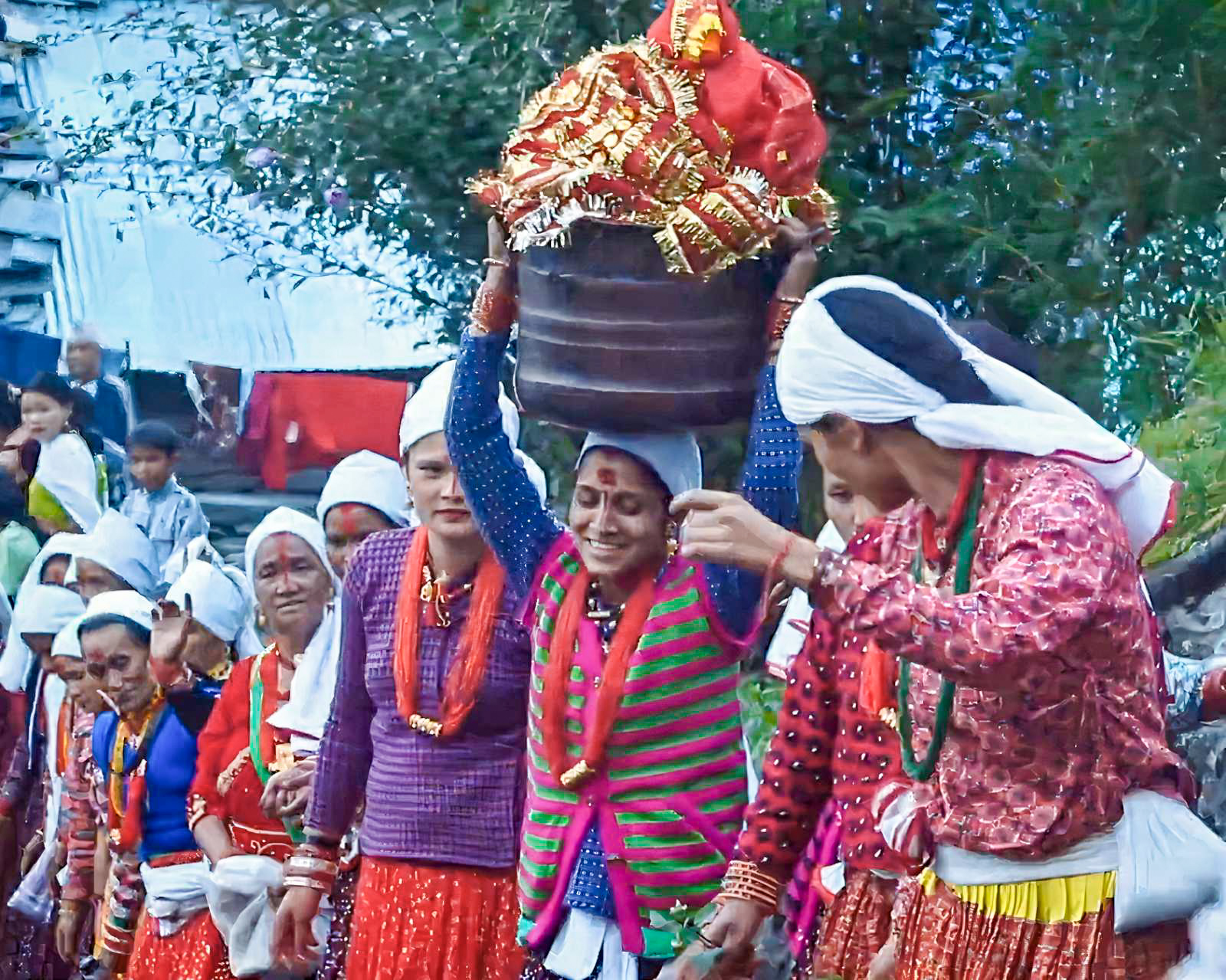Tradition | Culture | Sudurpaschim | Marriage commemoration | Gauri | Maheshwor

From Masa Shukla Paksha Panchami to Shukla Paksha Ashtami of the Nepali calendar month of Bhadra marks four-five days of Gaura Parva celebration in the Sudurpaschim Province. The Hindu deities Maheshwor (Shiva) and Gauri (Parvati) are worshipped during the festival, which is also called Gora or Gamara in native languages.
Also celebrated in some parts of Karnali Province and the crossborder Kumaon region of the Indian state Uttarakhand, Gaura Parva is a community festival commemorating the marriage of, as believed, [Bhagwan] Maheshwor — the resident of Kailash Parvat and [Mata] Gauri — the daughter of Himalayas. It is particularly celebrated by married women.
During Gaura, the women (known as Upavasi) fast throughout the day and eat one meal consisting of food such as Puri, Kheer, Sel roti, etc. at the end of the day. The use of garlic and onions in food and the consumption of meat are strictly prohibited, also for non-fasting family members.
In the house of the eldest relative, biruda consisting of five grains — gahat (horse gram), guraus (green lentil), kalau (pea), gahu (wheat), and maas dal (black lentil) — is installed. The house is then called Gora Ghar.
Biruda is offered to Maheshwor and Gauri and also accepted as parsadi at the end of the festival, the intake of which is believed to be blessed with good health among the family members.
On the first day of Gaura, fasting women gather in the community to pick and select grains (biruda). The selected grains are soaked overnight.
The second day is called Athwali (or Logai), when the soaked grains are carried to nearby rivulets or any available source of water for washing. While the women clean biruda, they sing Saguna — a Darchureli-language dedication song sung as a blessing on auspicious occasions such as marriage, which goes like this:
“Palla ghara dijju hamra panch birudi dhon jhaanau
Ekai paani dhoya birudi,
Duye paani dhoya birudi
Tinai paani dhoya birudi
Chaarai paani dhoya birudi
Panchai paani dhoya birudi… Ganga tath puji gyo”
Derived from a village of Darchula district, the above text translates to telling the neighbour “sisters” to arrive at the tap and wash pancha birudi together.
“Ekai paani dhoya birudi, duye paani dhoya...” — biruda are supposed to be washed five times before they are left for germination. The lyrics go on to count the frequency of washing to five times.
“Panchai paani dhoya birudi… Ganga tath puji gyo”, in this line, Ganga signifies heaven.
According to folklore, if the water used to wash biruda reaches heaven (Ganga), it supposedly brings good weather.
After the washing of the biruda, the effigy of Gauri, made using paddy and sesame hay and decorated with red clothes and jewellery, is worshipped.
On the morning of the third day along with Upavasi, a priest arrives at the Gora Ghar. Accompanied by musical instruments, the effigy of Gauri is brought to the Ghar and worshipped. In the evening, the women play Ranjhani — a type of Deuda.
Prevailing in the Sudurpaschim Province, Deuda is a type of dance in which feet move in the same rhythmic flow, hands go around the waist of the person next to you. In some places, you hold hands while dancing. The dance form varies from one district to another, culture to culture. In Darchula, Deuda is known as Gancha.
Women wear a sacred red thread containing seven strands of Bermuda grass (dubo) and seven knots called Saptame. They go home to eat and return to the Gora Ghar, stay awake, and sing devotional songs overnight.
On the final day of Gaura, the women wear traditional clothes: Fariya (skirt), Cholo, Patuki, and Thelki (white cloth worn on the head). They wear adornments like bangles, Chandrahaar, Jhumjhudi (which goes around the head), and Maala.

The effigy of Maheshwor is brought to the Gora Ghar through a procession on the tunes of Damaha, Jhyali, and Tamko, among others. Simultaneously, the women sing Saguna while worshipping Gauri and Maheshwor. Gauri is offered bindi, bangles, ghumto (red-colored veil), mirror, comb, vermilion, and camphor.
After seven rounds around Yagya or sacred fire (popularly known as Saat Phera), the marriage ceremony concludes. The songs sung aftermath tell the tale of Gauri and Maheshwor from their birth up to their marriage. Women wear red threads called dubo-dhago, made up of grass and sacred thread and symbolise married, around their necks.
A fair is organised where many men hold huge cloth with pancha biruda and other edible offerings hurled up to the sky. The women then need to catch it before it hits the ground. This whole act is called Fal Fadkaunu, where Fal means offerings, fruits, and fadkaunu means to hurl up. It is believed one should swallow the offering without using teeth to have their wish fulfilled.
At last, every family member is worshipped using biruda. The festival ends the next day after the effigies of Gauri and Maheshwor are placed in a temple.
The festival holds great weight in understanding the cultural background of Nepal’s far-western society. The excitement of Gaura stands more crucial than Dashain, Tihar, and other festivals in the region, making it the biggest festival here.
The celebration of this festival is however declining by the time. The songs sung while worshipping the deities are limited to a handful of old people with little to no youth learning and singing them. Similarly, Deuda is fading away from the scene, too.
--------------------------------------------------------------------------------------------
Edit by Vivek Baranwal
Read More Stories
Kathmandu’s decay: From glorious past to ominous future
Kathmandu: The legend and the legacy Legend about Kathmandus evolution holds that the...
Kathmandu - A crumbling valley!
Valleys and cities should be young, vibrant, inspiring and full of hopes with...
Understanding federal grants in fiscal federalism
Local budgets are where democracy meets the daily lives of citizensthis is a...